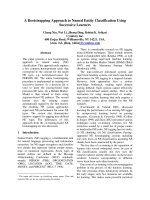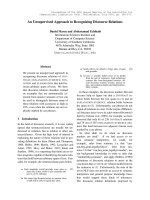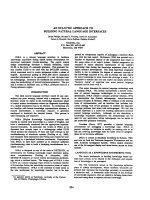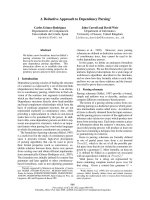Báo cáo khoa học: "KNOWLEDGE ENGINEERING APPROACH TO MORPHOLOGICAL ANALYSIS" pot
Bạn đang xem bản rút gọn của tài liệu. Xem và tải ngay bản đầy đủ của tài liệu tại đây (295.08 KB, 3 trang )
KNOWLEDGE ENGINEERING APPROACH TO MORPHOLOGICAL ANALYSIS*
Harri J~ppinen I , Aarno Lehtola, EsaNelimarkka 2, and Matti Ylilammi
Helsinki University of Technology
Helsinki, Finland
ABSTRACT
Finnish is a highly inflectional language. A
verb can have over ten thousand different surface
forms - nominals slightly fewer. Consequently, a
morphological analyzer is an important component
of a system aiming at "understanding" Finnish.
This paper briefly describes our rule-based heu-
ristic analyzer for Finnish nominal and verb
forms. Our tests have shown it to be quite
efficient: the analysis of a Finnish word in a
running text takes an average of 15 ms of DEC 20
CPU-time.
I INTRODUCTION
This paper briefly discusses the application
of rule-based systems to the morphological analy-
sis of Finnish word forms. Production systems seem
to us a convenient way to express the strongly
context-sensltive segmentation of Finnish word
forms. This work demonstrates that they can be
implemented to efficiently perform segmentations
and uncover their interpretations.
For any computational system aiming at
interpreting a highly inflectional language, such
as Finnish, the morphological analysis of word
forms is an important component. Inflectional suf-
fixes carry syntactic and semantic information
which is necessary for a syntactic and logical
analysis of a sentence.
In contrast to major Indo-European languages,
such as English, where morphological analysis is
often so simple that reports of systems processing
these languages usually omit morphological
discussion, the analysis of Finnish word forms is
a hard problem.
A few algorithmic approaches, i.e. methods
using precise and fully-informed decisions, to a
morphological analysis of Finnish have been
reported. Brodda and Karlsson (1981) attempted to
find the most probable morphological segmentation
for an arbitrary Finnish surface-word form without
a reference to a lexicon. They report surprisingly
high success, close to 90 %. However, their system
neither transforms stems into a basic form, nor
finds morphotactic interpretations. Karttunen et
*This research is being supported by SITRA (Finnish
National Fund for Research and Development)
P.O. Box 329, 00121Helsinki 12, Finland
IDigitalSystems Laboratory
21nstitu~e of Mathematics
al. (1981) report a LISP-program which searches in
a root lexicon and in four segment tables for
adjacent parts, which generate a given surface-
word form. Koskenniami (1983) describes a rela-
tional, symmetric model for analysis, as well as
for production of Finnish word forms. He, too,
uses a word-root lexicon and suffix lexicons to
support comparisons between surface and lexical
levels.
Our morphological analyzer MORFIN was planned
to constitute the first component in our forth-
coming Finnish natural-language database query
system. We therefore rate highly a computationally
efficient method which supports an open lexicon.
Lexical entries should carry the minimum of
morphological information to allow a casual user
to add new entries.
We relaxed the requirement of fully informed
decisions in favor of progressively generated and
tested plausible heuristic hypotheses, dressed in
production rules. The analysis of a word in our
model represents a multi-level heuristic search.
The basic control strategy of MORFIN resembles the
one more extensively exploited in the Hearsay-II
system (Erman et al.,1980).
II FINNISH MORPHOTACTICS
Finnish morphotactics is complex by any ordi-
nary standard. Nouns, adjectives and verbs take
numerous different forms to express case, number,
possession, tense, mood, person and other morpheme
categories. The problem of analysis is greatly
aggravated by context sensitivity. A word stem may
obtain different forms depending on the suffixes
attached to it. Some morphemes have stem-dependent
segments, and some segments are affected by other
segments juxtaposed to it.
Due to lack of space, we outline here only
the structure of Finnish nominals. The surface
form of a Finnish nominal ~ay be composed of the
following constituents (parentheses denote
optionality) :
(I) root + ste~ending + number + case
+ (possessive) + (clitic)
The stem endings comprise a large collection
of highly context-sensitive segments which link
the word roots with the number and case suffixes
in phonologically sound ways. The authorative Dic-
tionary of Contemporary Finnish classifies nomi-
49
nals into 85 distinct paradigms based on the
variation in their stem endings in the nominative,
genetive, partitive, essive, and illative cases.
The plural in a nominal is signaled by an 'i',
'j', 't', or the null string (4) depending on the
context. The fourteen cases used in Finnish are
expressed by one or more suffix types each.
Furthermore, consonant gradation may take place in
the roots and stem endlngs with certain manifesta-
tions of 'p', 't' or 'k'.
As an example, consider the word 'pursi'
(=yacht). The dictionary representation 'pu~ si 42'
indicates the root 'put', . the stem ending 'si' in
the nominative singular case, and the paradigm
number 42. Among others, we have the inflections
(2) pur + re + d + lla + mne + kin
(=also on our yacht)
put + s + i + lla + nme + ko
(=on our yachts?)
Consonant gradation takes place, for
instance, in the word 'tak~ i 4' (=coat) as
follows:
(3) tak + i + ~ + ssa + ni (=in my coat)
tak k + e + i + hi + ni (=into my coats)
III DESCRIPTION OF THE HEURISTIC METHOD
A. Control Structure
Our heuristic method uses the hypothesis-and-
test paradigm used in many AI systems. A global
database is divided into four distinct levels.
Productions, which carry local heuristic
knowledge, generate or confirm hypotheses between
two levels as shown in the figure.
input surface-word form level
>
'"I I
morpheme
~
productions morphote©Uo level
stem beslu - word
pr oductions form level
dictionary confirmation
look*up level
)
output
Figure. The control structure of MORFIN.
B. Morpheme Productions
Morpheme productions recognize legal morpho-
logical surface-segment configurations in a word,
and slice and interprete the word accordingly. We
use directly the allomorphic variants of the
morphemes. Since possible segment configurations
overlap, several mutually exclusive hypotheses are
usually produced on the morphotactic level. All
valid interpretations of a homographic word form
are among them.
The extracted rules were packed and compiled
into a network of 33 distinct state-transition
automata (3 for clitic, I for person, 6 for tense,
3 for case, 2 for number, 5 for adjective com-
paration, 3 for passive, 5 for participle, and 5
for infinitive segments). These automata were
generated by 204 morpheme productions of the form:
(4) name: (2nd_context)(Ist context)segment >
POSTULATE-~int er pr etat i on, next )
'Segment' exhibits an allomorph; the optional
'Ist' and '2nd contexts' indicate 0 to 2 left-
contextual letters. The operation POSTULATE
separates a recognized segment, attaches an
interpretation to it, and proceeds to the indi-
cated automata ('next'). For example, the produc-
tion
(5) LZ~n > POSTULATE([gen,sg, ],
~TGMI, NUM2, PAR I, PAR4, PAR5, INF3, INF4, COMP4] )
recognizes the substring 'n', if preceeded by a
vowel, as an allomorph for the singular genetive
case, separates 'n', and proceeds in parallel to
two automatons for number, three for participles,
two for infinitive, and one for comparation.
C. Stem Productions
Stem productions are case- and number-
specific heuristic rules (genus-, mood- and tense-
speslflc for verbs) postulating nominative singu-
lar nouns as basic forms (Ist infinitive for
verbs) which, under the postulated morphotactic
interpretation, might have resulted in the
observed stem form on the morphotactic level. They
may reject a candidate stem-form as an impossible
transformation, or produce one or more basic-form
hypotheses.
The Reverse Dictionary of Finnish lists close
to 100 000 Finnish words sorted backwards. For
each word the dictionary tags its syntactic
category and the paradigm number. From that corpus
we extracted heuristic information about equiva-
lence classes of stem behavior. This knowledge we
dressed into productions of the following form:
(6) condition > POSTULATE(cut,string,shift)
If the condition of a production is
satisfied, a basic-form hypothesis is postulated
on the basic word-form level by cutting the
recognized stem, adding a new string (separated by
a blank to indicate the boundary between the root
and the stem ending), and possibly shifting the
blank. These operations are indicated by the argu-
ments 'cut', 'string', and 'shift'. A well-formed
condition (WFC) is defined recursively as follows.
Any letter in the Finnish alphabet is a WFC, and
such a condition is true if the last letter of a
stem matches the letter. If &1 ,&2, ,&n are WFCs,
then the following constructions are also WFCs:
(7) (1)
&2&l
(II) <&1 ,&2, • • • ,&n >
50
(I) is true if &1 and &2 are true, in that
order, under the stipulation that the recognized
letters in a stem are consomed. (II) is true if
&1 or &2 or or &n is true. The testing in (II)
proceeds from left to right and halts if recogni-
tion occurs. The recognized letters are cons~ed.
A capital letter can be used as a macro name for a
WFC. For example, a genetive 'n'-specific produc-
tion
(8) <Ka,y>hde ~> POSTULATE(3,'ksi',0)
('K' is an abbreviation for <d,f,g,h >
-
the consonants) recognizes, among other stems,
the genetive stem 'kahde' and generates the basic
form hypothesis 'ka ksi' (: two).
We collected 12 sets of productions for nomi-
nal and 6 for verb stems. On average, a set has
about 20 rules. These sets were compiled into 18
efficient state-transition automata.
We could also apply productions to consonant
gradation. However, since a Finnish word can have
at most two stems (weak and strong), MORFIN trades
storage for computation and stores double stems in
the lexicon.
D. Dictionary Look-up
The dictionary lock-up procedure confirms or
rejects the baslc-word form hypotheses that have
proliferated from the previous stages by matching
them against the lexicon. Thus in MORFIN the only
morphological information a dictionary entry
carries is the boundary between the root and the
stem ending in the basic-word form and grade. All
other morphological knowledge is stored in MORFIN
in an active form as rules.
In MORFIN, input words are totally analyzed
before a reference to the lexicon happens. Con-
sequently, also words not existing in the lexicon
are analyzed. This fact and the simple lexical
form make it easy to add new words in the lexicon:
a user simply chooses the right alternative(s)
from postulated baslc-word form hypotheses.
IV DISCUSSION
MORFIN has been fully implemented in standard
PASCAL and is in the final stages of testing. The
lexicons contain nearly 2000 most frequent Finnish
words. In addition to one lexicon for nominals,
and one for verbs, MORFIN has two "front" lexicons
for unvarying words, and words with slight
variation (pronouns, adverbs etc. and those with
exceptional forms).
Currently MORFIN does not analyze compound
nouns into parts (as Karttunen et al. (1981) and
Koskenniemi (1983) do). By modifying our system
slightly we could do this by calling the system
recursively. We rejected this kind of analysis
because the semantics of many compounds must be
stored as separate lexical entries in our database
interface anyway. MORFIN does not 2roduce word
• forms as the other two systems do.
With respect to the goals we set, our tests
rate MORFIN quite well (J~ppinen et al., 1983).
Lexical entries are simple and their addition is
easy. On average, only around 4 basic-word form
hypotheses are produced on the basic-word form
level. The analysis of a word in randomly selected
newspaper texts takes about 15 ms of DEC 2060 CPU-
time. Karttunen et al. (1981) report on their
system that "It can analyze a short unambiguous
word in less than 20 ms [DEC-2060/Interlisp] a
long word or a compound can take ten times
longer." Koskenniemi (1983) writes that "with a
large lexicon it L1~is system] takes about 0.1CPU
seconds EBurroughs B7800/PASCAL] to analyze a
reasonably complicated word form."
Both Karttunen et al. (1981) and Koskenniemi
(1983) proceed from left to right and compare an
input word with forms generated from lexical
entries. It is not clear how such models explain
the phenomenon that a native speaker of Finnish
spontaneously analyzes also granm~atical but
meaningless word forms. Most Finns would probably
agree that, for instance, 'vimpuloissa' is a
plural inessive form of a meaningless word
'vimpula'. How can a model based on comparison
function when there is no lexical entry to be com-
pared with? Our model encounters no problems with
new or meaningless words. 'Vimpuloissa', if given
as an input, would produce, among others, the
hypothesis 'vimpul a' with correct interpretation.
It would be rejected only because it is a non-
existent Finnish word.
ACKNOWLEDC~TS
Lauri Carlson has given us helpful linguistic
comments. Vesa Yl~J~ski and Panu VilJamaa have
implemented parts of MORFIN. We greatly appreciate
their help.
REFERENCES
Brodda, B. and Karlsson, F., An experiment with
automatic morphological analysis of Finnish. Un.
of Stockholm, Insitute of Linguistics, Publica-
tion 40, 1981.
Erman, L.D. et al., The Heareay-II speech-
understanding system: integrating knowledge to
resolve uncertainty. Computing Surveys, Vol. 12,
No 2, (June, 1980), 213-253.
J~ppinen H., Lehtola, A., Nelimarkka, E., and Yli-
l~i, M., Morphological analysis of Finnish: a
heuristic approach. Helsinki University of Tech-
nology, Digital Systems Laboratory, 1983
(forthcoming report).
K~rlsson, F., Finsk Gra~m~tik. Suomalaisen Kir-
jallisuuden Seura, 1981.
Karttunen, L., Root, R., and Uszkoreit, H.,
TEXFIN: Morphological analysis of Finnish by
computer. The 71st Ann. Meeting of the SASS,
Albuquerque, 1981.
Koskenniemi, K., Two-level model for morphological
analysis. IJCAI-83, 1983, 683-685.
51









